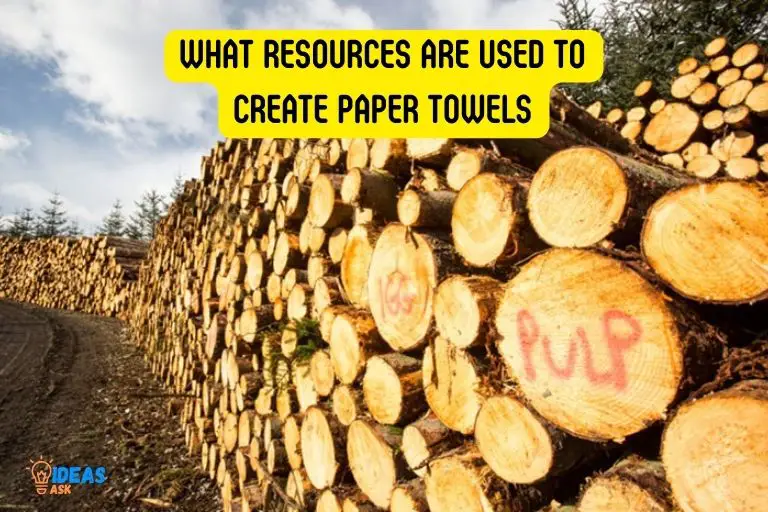What Resources are Used to Create Paper Towels? Paper Pulp!
The main resource used to create paper towels is paper pulp.
Paper pulp is typically made from wood fibers obtained from trees, but it can also be sourced from recycled paper materials.
The wood fibers are broken down into a pulp through a mechanical or chemical process. Once the pulp is ready, it is then processed, pressed, and dried to form the paper towels.
Additional resources such as chemical, water and energy are also required in the manufacturing process, but paper pulp is the primary raw material used for paper towel production.

Key Takeaway
Understanding The Making Of Paper Pulp As A Resource
Paper towels are essential commodities in today’s world, and they are commonly used in homes, offices, and restaurants.
They are made from various resources, and paper pulp is the primary raw material for the production of paper towels.
Introduction To Paper Pulp And Its Importance To The Paper Towel Industry
Paper pulp is a cellulose-based product made by processing wood chips or recycled paper. It can also be produced from non-wood fibers such as cotton and sugarcane. Paper pulp is a crucial resource in the paper towel industry.
Here are some of the reasons why:
- Paper pulp can be produced from both virgin wood fibers and recycled paper, making it an eco-friendly resource.
- It has excellent absorbency and wet strength properties, making it suitable for use in different types of paper towels.
- Paper pulp can be easily bleached and treated with other chemicals to enhance its properties.
Processes Involved In The Creation Of Paper Pulp
The process of creating paper pulp involves several steps, including:
- Pulping: This involves breaking down the wood chips or recycled paper into a pulp. It can be done mechanically or chemically, with the latter method being the most common.
- Bleaching: This step involves treating the pulp with chemicals such as hydrogen peroxide and sodium hydrosulfite to remove impurities and improve its brightness.
- Treating and refining: The pulp is treated with different chemicals and refined to enhance its properties.
- Drying: The treated pulp is dried and turned into sheets of paper, which are then used to produce paper towels.
Types Of Wood Used In The Production Of Paper Pulp For Paper Towels
Different types of wood can be used to produce paper pulp for paper towels.
Some of the commonly used ones include:
- Softwood: This type of wood comes from coniferous trees such as pine and fir. It is widely used in the production of paper towels because it has long fibers that provide superior strength and absorbency.
- Hardwood: This type of wood comes from trees such as birch, maple, and oak. It is less commonly used because it has shorter fibers that produce weaker and less absorbent paper pulp.
- Recycled paper: This is an eco-friendly option that involves processing used paper products to create paper pulp. It reduces the demand for virgin wood fibers and helps to conserve natural resources.
Paper pulp is an essential resource in the paper towel industry, and its production involves several steps. The type of wood used affects the properties of the paper pulp produced, and recycled paper is an eco-friendly alternative.
The Role Of Chemicals In Creating Paper Towels
Paper towels are not made from only wood pulp but with the help of chemicals. Several chemicals are used in the production of paper towels, and they play a crucial role in determining the strength, absorbency, and softness of the paper towel.
Understanding the chemicals involved in making paper towels can help us make informed decisions about their usage.
Overview Of Chemical Processes Involved In Paper Towel Production
The chemical processes involved in the production of paper towels are:
- Pulping: Wood fibers are separated from logs through mechanical and chemical processes, such as chipping, grinding, and chemical digestion.
- Bleaching: To whiten the pulp and remove impurities, chlorine or chlorine-free chemicals are used in a bleaching process.
- Cleaning: The pulp undergoes cleaning stages to remove any remaining debris and unwanted materials.
- Beating: Pulp is mechanically beaten to improve its quality, increase fiber flexibility, and enhance paper towel strength.
- Additives: Various chemicals may be added to the pulp, such as wet strength additives, sizing agents, and colorants, to achieve specific properties.
- Paper Formation: The pulp is diluted with water and formed into sheets using a paper machine, where it’s further processed and dried.
- Calendering: The paper sheets are run through rollers to smooth and improve the paper’s surface.
- Cutting and Packaging: The finished paper is cut into individual paper towel rolls or sheets and packaged for distribution.
- Waste Treatment: Effluents generated during production are treated to reduce environmental impact.
Understanding the chemical processes involved in the production of paper towels can help us make informed decisions about their usage.
While the chemicals used in making paper towels are generally safe, it is essential to be aware of the potential risks associated with using them.
Water & Energy as Essential Resource of Paper Towels
Water Usage:
- Water is crucial for the papermaking process, primarily for pulping and forming the paper slurry.
- It aids in breaking down raw materials, like wood fibers, into a pulp that can be further processed into paper towels.
- Water is also used in cleaning and refining the pulp to ensure high-quality paper production.
Energy Consumption:
- Energy is needed at various stages of paper towel manufacturing, including pulp processing, drying, and transportation.
- Electricity powers machinery and equipment within paper towel factories.
- Fuel is consumed in transporting raw materials, such as logs or paper pulp, to the manufacturing facilities.
- Energy is also expended in the distribution of finished paper towels to consumers, including transportation to retail stores or direct deliveries.
Both water and energy resources play critical roles in the production of paper towels and have environmental and economic implications.
Exploring Alternative Resources For Paper Towel Production
Latest Technologies And Innovations In Resource-Conserving Paper Towel Production
The use of new technologies in paper towel production has brought about significant changes in the industry, making it easier to optimize resource utilization.
Here are some of the latest innovations being used in resource-conserving paper towel production:
- Hybrid technology: This involves using recycled fibers and virgin pulp to achieve quality output while ensuring responsible sourcing and reducing waste.
- Low-impact manufacturing processes: Modern paper towel manufacturing processes have been re-engineered using technology that is less harmful to the environment, including energy-efficient machines and closed-loop systems that save water and fiber.
- Alternative fibers: Companies are experimenting with bamboo and other plant-based fibers as a sustainable alternative to traditional wood pulp.
The Role Of Recycled Materials In Developing Sustainable Paper Towel Production Processes
The use of recycled materials is a key aspect of sustainable paper towel production.
Here’s how recycled materials are used in the process:
- Recycled fibers: These are obtained by processing used paper towels. The resulting pulp is mixed with virgin fibers to create new paper towel products.
- Recycled water: Paper towel manufacturing facilities use a lot of water, and recycling used water in the process contributes to conservation efforts.
- Recycled packaging materials: Companies are experimenting with sustainable packaging materials, such as biodegradable plastics and recycled cardboard, to reduce the environmental impact of packaging.
Benefits And Limitations Of Using Alternative Resources In Paper Towel Creation
Creating paper towels using alternative resources comes with both advantages and disadvantages. Here are some of the benefits and limitations:
Benefits:
- Reduced environmental impact: Using alternative resources such as bamboo and recycled materials in the creation of paper towels is more sustainable and reduces the industry’s carbon footprint.
- Cost-effective: Some alternative resources used in the creation of paper towels, such as bamboo, are much more cost-effective than traditional wood pulp.
- Diversifies the supply chain: Using alternative resources opens up new sources of materials, which helps to diversify the supply chain and ensure a steady supply of materials.
Limitations:
- Quality concerns: Alternative resources such as bamboo may produce paper towels that don’t meet quality expectations due to differences in fiber structure.
- Limited availability: While some alternative resources are cost-effective, their availability to paper towel manufacturers could be restricted by production and supply chain limitations.
- Production challenges: Developing sustainable paper towel production processes using alternative resources requires significant investment in research and development, which could be a significant challenge for some companies.
Conclusion
It is clear that paper towels are an essential part of our daily lives, and their production depends on various resources.
The process of making paper towels starts with harvesting trees, and then they go through several processes to turn them into pulp, which eventually becomes paper towels.
While it is crucial to maintain a hygienic and clean environment, we must also consider the environment and the impact we have on it by using paper towels.
Therefore, we need to ensure that companies use eco-friendly and sustainable practices during the manufacturing process.
As consumers, we can also play our part by reducing our paper towel consumption or switching to reusable alternatives.
Nonetheless, the production of paper towels continues to evolve, and with advancements in technology and increasing awareness about sustainability, we can hope to see more sustainable practices adopted in the future.






